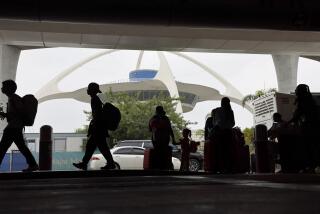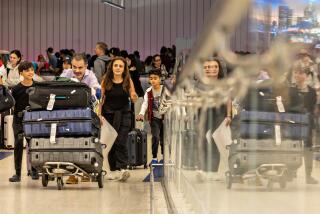U.S. to Step Up Luggage Checks Plan Outlined for Explosives Check
WASHINGTON — WASHINGTON -- Millions of airline passengers will soon be asked to open their checked bags for explosives inspection, federal officials said Tuesday as they outlined new details of the government’s planned takeover of airport security.
The added inconvenience to travelers, experts said, will be the price of trying to meet a Dec. 31 deadline for screening all checked bags with explosives detection equipment. “People do not like someone going through their personal effects in their checked baggage,” said David Stempler, president of the Air Travelers Assn., an advocacy group for travelers. “They are going to have to grin and bear it.”
The security checks should take no more than two-and-a-half minutes, officials promised, citing results from a pilot program at the Norfolk, Va., airport. International travelers are used to opening their luggage for customs inspectors, but until now, domestic passengers have only had to deal with searches of their carry-on items.
The luggage policy will be phased in as uniformed federal passenger and baggage screeners begin staffing airport checkpoints in force later this summer, transportation officials said. The Transportation Security Administration screeners must meet stricter qualifications and complete more rigorous training than did the private guards they are replacing. The goal is more effective and consistent security at 429 airports with regular airline service.
At Los Angeles International Airport, the federal takeover will begin by the first week in July with the arrival of a “site assessment team” to begin mapping out a complex choreography that will unfold over the next several months. An early version of the LAX plan, displayed at a news conference here, had hundreds of small-print line items on two sheets of paper the size of large posters.
“We’re moving from the planning phase to action,” said Transportation Department spokesman Chet Lunner. “If this were a sports team, opening day would be next week.” The first 23 site assessment teams will be deployed Monday to a sample of medium and smaller airports, including Palm Springs International. Of the larger airports, Newark and Boston will be among the first to get federal screeners. Two of the planes hijacked in the terrorist assault of Sept. 11 took off from Boston and one from Newark.
Congress has set deadlines of Nov. 19 for federal screeners to be in place at all airports and Dec. 31 for all checked bags to be screened with explosives detection systems.
“There is pretty broad skepticism from a lot of people about these deadlines,” acknowledged Stephen McHale, deputy director of the new security agency. “They are daunting.”
More than 32,000 screeners will be needed to staff passenger checkpoints and at least another 21,500 to handle checked luggage. McHale said he is confident the agency can have them all in place.
The new policy for screening checked baggage is widely seen as the organization’s most difficult challenge. Before Sept. 11, the Federal Aviation Administration had approved a bomb screening technology that uses computed tomography (CT) scanners to generate three-dimensional images of objects in closed bags. But not enough of the minivan-sized machines could be built and installed by Dec 31.
The security agency also decided to bring in smaller trace-detection units, which can pick up residue left by explosives on the outside of closed bags or amid the contents of open ones. The operator of a trace machine wipes a cotton swab on the bag, then places the swab into an analyzer, which sounds an alarm if a suspicious substance is detected.
Trace detectors are much more effective when a bag is opened, so intrusive inspections are required to guarantee a high level of security.
The government is buying up to 1,100 CT scanners and 4,800 to 6,000 trace detectors. Travelers can already see both systems at airports. Trace units are now used to check for explosives in shoes. Many airports will employ a mix of the two technologies to screen checked luggage.
Some travelers will experience an extensive inspection of the contents of their checked bags, said Randy Null, senior advisor for explosives detection for the security agency.
Other travelers will be asked to open their bags, but only the larger items inside will be swabbed for explosives residues. Some travelers will have only the outside of their bags tested.
“Privacy is certainly an issue,” Null said. “We are looking at different types of partitions and ways to shelter the bag and its contents.” Trace inspection might be done at curbside or during check-in, he said.
Stempler, the advocate for passengers, said the government should build an automated system to screen checked bags for possible bombs. “We’re a technological nation, and we should be able to figure out how to do this.”
More to Read
Sign up for Essential California
The most important California stories and recommendations in your inbox every morning.
You may occasionally receive promotional content from the Los Angeles Times.










